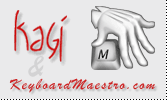Here are a number of example and suggestions for Macros to give you some ideas of how you can get the most out of Keyboard Maestro and your Mac. For tips on how to remember which Hot Key executes which action, see the Remembering Macro Hot Keys section.
Use function keys to launch or switch to your most used applications. For example, you probably often switch to the Finder, your Email client, your Web Browser, your Word Processor. Consider putting these and other frequently used applications on function keys.
Use control-function keys to open your most used documents. For example, you might have a documentation file or financial details file that you access frequently, consider putting these on control-function keys.
Use control-letter keys and the Insert Text action to type in text for you, such as your name, address, phone number, and so on. Consider restricting these to just the appropriate applications like your Email client or Word Processor by creating a Macro Group for them.
If you keep your finances on your computer, then you probably need to open a document every time you enter a bill or receive a statement. By creating a Hot Key to open the document for you, you can save a few seconds every time - at least it might make receiving a bill slightly less unpleasant! If you have multiple accounts (eg personal, business, association) then this can be even more useful.
You could use Hot Keys to connect to your common servers. You might need to create a Bookmark file for the site and use the Open File Macro Action.
You could Use Hot Keys to Insert Text, Simulate Tab Press, Insert Text, Simulate Return Press to make effective bookmarks for applications that do not have an inbuilt bookmark system or to enter form data. While you could use this to enter usernames and passwords I would advise you use a tool like Web Confidential for such things as it will provide secure storage for your password.
If you find yourself pressing a command key in an application and expecting it to do something but it does not work (for example, command-T for “Replace and Find Again”), use a Macro to make the command key “do the right thing” in that application. Similarly, if you use a function in an application frequently, but it has a convoluted command key or no command key at all, define your own command key by using a Hot Key to select the menu item.
If you find yourself missing a feature in one application that you are used to in another application (perhaps you switched email clients and a feature is missing), see if you can simulate the feature with a sequence of commands and then use a Hot Key for that. For example, Close Window, Down Arrow, Return to move to next email message.
If you often type characters out of order, use a Hot Key to swap them by first placing the cursor between them and then executing:
If you often want to save snippets of text, you could create a Hot Key to save a clipping:
If you always do a set of things every time you launch an application (eg arrange the windows in a particular way), use an application Macro Trigger to execute a Macro when you launch the application, then have the Macro do the work for you.
If you always do something after quitting an application (eg unmount a server or disconnect from the Internet), use an application Macro Trigger to execute a Macro when you quit the application. You might need to do a little AppleScripting to perform the action and then use the Execute AppleScript action.
A Macro can play a System Beep when it is executed, but if you want to do something more, you can use an AppleScript or Unix script to play a sound (perhaps using the free utility Play Sound, AppleScript tell application "PlaySound" to play file "..."), speak text (AppleScript say "hello") or display an alert (AppleScript display dialog "hello").
By adding sound effects to your Macro sequences you can give clear feedback as to what is happening.
Continue on to Program Switcher

Conduct your Mac Like a Pro!